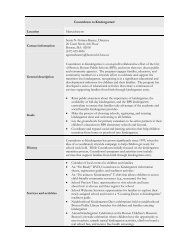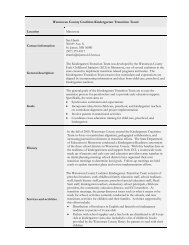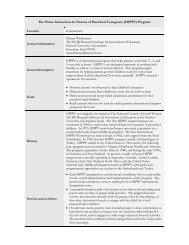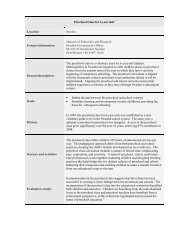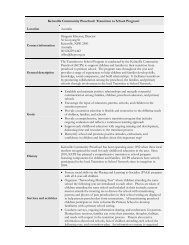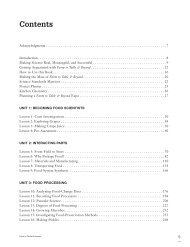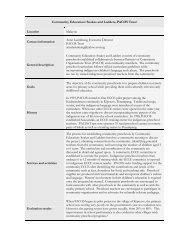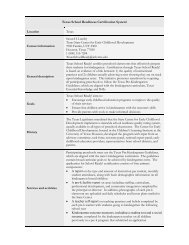Proceedings of the Fourth Annual Teachers College Educational ...
Proceedings of the Fourth Annual Teachers College Educational ...
Proceedings of the Fourth Annual Teachers College Educational ...
Create successful ePaper yourself
Turn your PDF publications into a flip-book with our unique Google optimized e-Paper software.
User Experiences with Avatar Customization in<br />
Second Life and Lord <strong>of</strong> <strong>the</strong> Rings Online<br />
Selen Turkay,<br />
<strong>Teachers</strong> <strong>College</strong>, Columbia University, 525W 120 th St, New York, NY, 10027<br />
Email: st2282@columbia.edu<br />
Abstract: This paper will present an exploratory study on users’ experiences with avatar<br />
customization tools in two different virtual worlds: a social virtual world, Second Life and a<br />
massively multiplayer online role playing game (MMORPG), Lord <strong>of</strong> <strong>the</strong> Rings Online<br />
(LotRO). Preliminary findings highlight fundamental differences in participants’<br />
engagement in avatar creation and experience with <strong>the</strong> tools.<br />
Introduction<br />
The word “avatar” has become very common in daily life thanks to an increasing number <strong>of</strong> virtual worlds<br />
(Kzero, 2011), and various consumer media, including James Cameron’s film Avatar. In virtual worlds, an<br />
avatar is <strong>the</strong> graphical representation <strong>of</strong> <strong>the</strong> user. Avatars’ visual and behavioral characteristics depend<br />
on <strong>the</strong> <strong>the</strong>me and technical aspects <strong>of</strong> a virtual world. For example, Linden Lab chose “Your World. Your<br />
Imagination” motto for Second Life (SL) allowing its users to customize <strong>the</strong>ir avatars to a great extent. SL<br />
provides over 150 unique sliders for users to customize <strong>the</strong>ir avatar appearance (Linden Lab, 2008).<br />
Creating avatars can be considered a form <strong>of</strong> art in SL but it may be challenging to design a desired<br />
avatar for a novice user with <strong>the</strong>se sliders. This is similar to <strong>the</strong> experience in <strong>the</strong> Metaverse, which <strong>the</strong><br />
idea <strong>of</strong> SL is based on, as described in Snow Crash (Stephenson, 1992). O<strong>the</strong>r virtual worlds provide<br />
users with different choices. For example, <strong>the</strong> Lord <strong>of</strong> <strong>the</strong> Rings Online is Tolkein’s Lord <strong>of</strong> <strong>the</strong> Rings<br />
books. In this game, players can choose among four races (humans, elf, hobbit and dwarf) and nine<br />
classes. Each race and class has different characteristics both in appearance and as abilities. When<br />
users customize <strong>the</strong>ir avatar appearance, <strong>the</strong>y scroll through preset options for head shape, eye shape,<br />
hair style, mouth, nose and so on and have a wide range <strong>of</strong> choice for colors (such as eye color, skin<br />
color and hair color). They can also adjust weight and build.<br />
Study<br />
Previous studies showed that customizing avatars can effect users’ enjoyment, and using customized<br />
avatars may increase learning and engagement in a virtual world (Bailey, Wise & Bolls, 2009; Turkay,<br />
2011). However, if we are to study <strong>the</strong> relation between <strong>the</strong> extent <strong>of</strong> avatar customization and user<br />
relations with <strong>the</strong>ir avatars, we have to take available technology and tools into consideration. For this<br />
purpose, we designed a study with two different virtual worlds: a social virtual world, SL, and a massively<br />
multiplayer online roleplaying game (MMORPG), Lord <strong>of</strong> <strong>the</strong> Rings Online (LotRO). Thirty-two participants<br />
(female=17, male=15) were asked to create a SL avatar as part <strong>of</strong> <strong>the</strong>ir assignment in a graduate level<br />
class. Forty participants (female=21, male=19) were asked to create an avatar by using LotRO avatar<br />
creation tools. In both conditions, participants were aware that <strong>the</strong>y would be represented in <strong>the</strong> virtual<br />
world by <strong>the</strong> avatar over multiple play sessions. After avatar customization, participants were asked to fill<br />
out a 5-point Likert scale survey about <strong>the</strong>ir avatar customization experience (O’Brian & Toms, 2009).<br />
Open-ended questions asked why participants customized <strong>the</strong>ir avatars <strong>the</strong> way <strong>the</strong>y did, and <strong>the</strong><br />
reasons for <strong>the</strong>ir naming choice.<br />
Results<br />
Preliminary results show that <strong>the</strong>re are significant differences between users’ engagement in customizing<br />
<strong>the</strong>ir avatars in LotRO and SL. In general, LotRO players were engaged in <strong>the</strong>ir avatar customization<br />
process significantly more than SL users were (p



